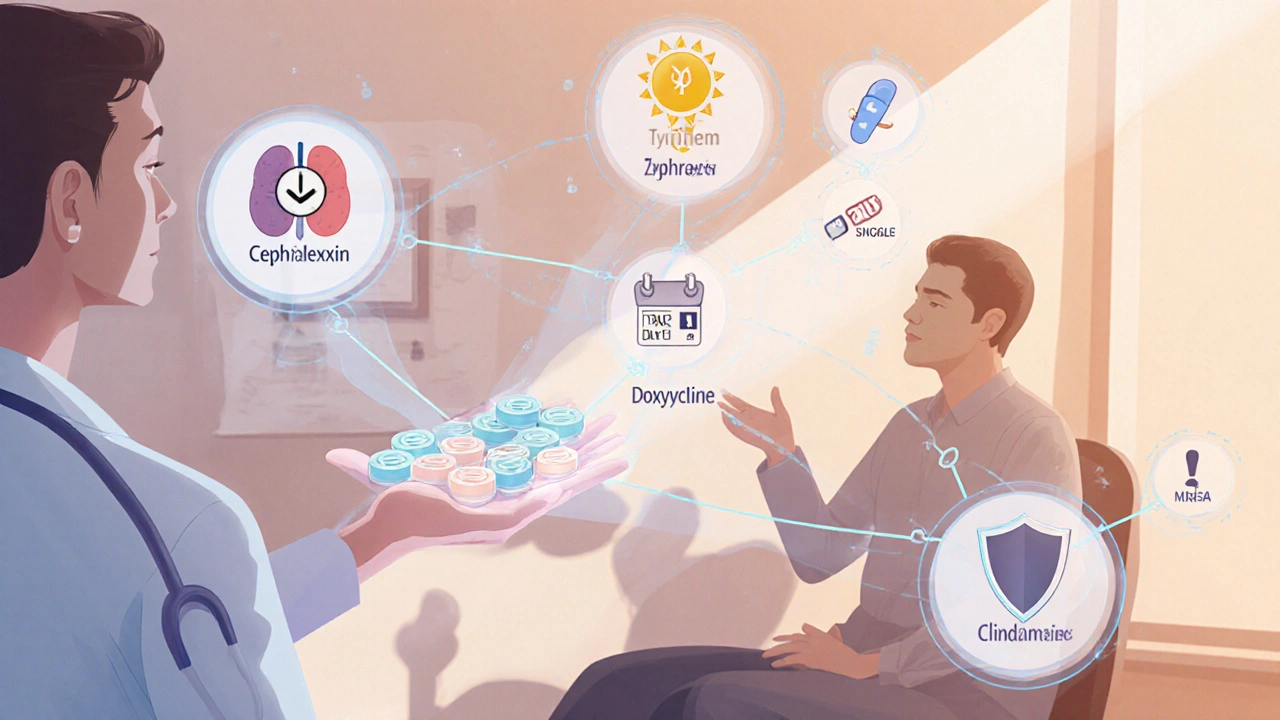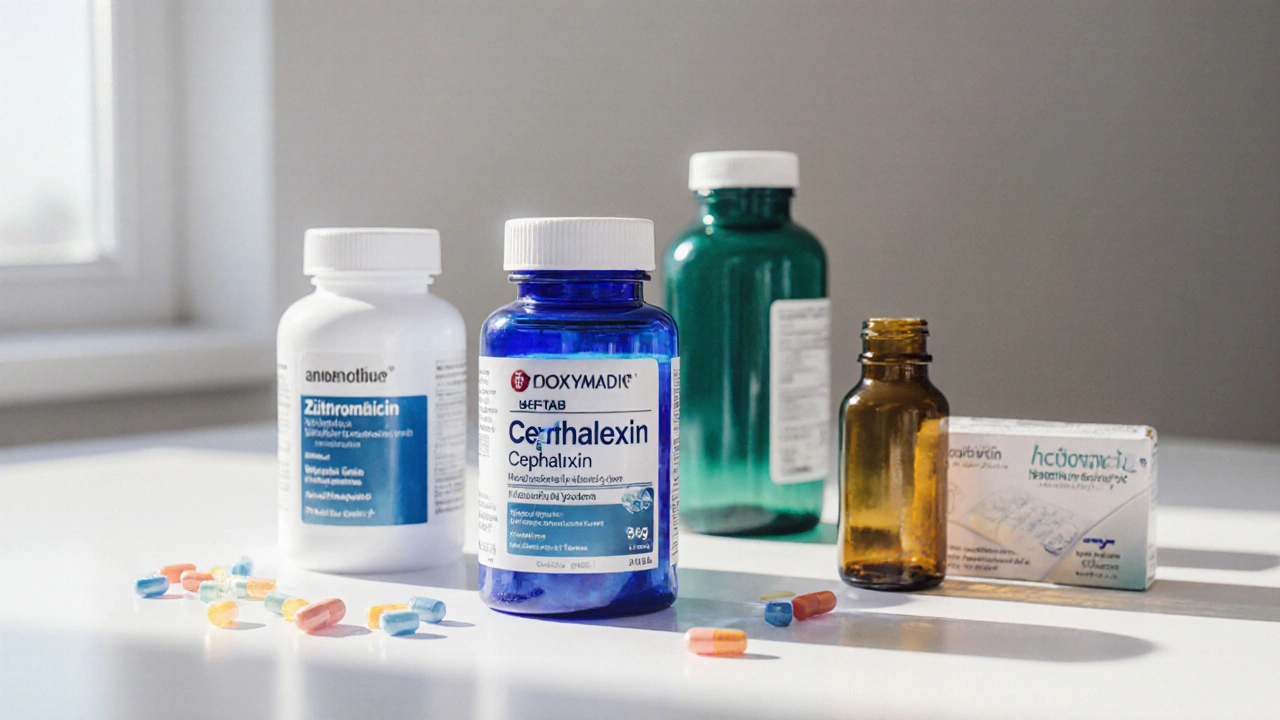Cephalexin vs Alternative Antibiotics Decision Tool
Quick takeaways
- Cephalexin (Keftab) is a first‑generation cephalosporin that works best for skin, bone and uncomplicated urinary infections.
- Amoxicillin, azithromycin and doxycycline cover many of the same bugs but differ in dosing frequency and side‑effect profile.
- Allergy to penicillin often means cephalexin is safe; however, severe cephalosporin cross‑reactivity can occur.
- Cost varies: generic cephalexin and amoxicillin are usually under $10 for a typical course, while azithromycin and clindamycin tend to be pricier.
- Choose an alternative when the infection is caused by atypical bacteria, when resistance to cephalosporins is known, or when a once‑daily regimen is needed.
What is Cephalexin (Keftab)?
Cephalexin is a first‑generation oral cephalosporin antibiotic marketed in many countries under the brand name Keftab. First approved in the 1970s, it remains a go‑to drug for uncomplicated skin, bone and urinary tract infections caused by Gram‑positive bacteria such as Staphylococcus aureus (non‑MRSA) and Streptococcus pyogenes. Typical adult dosing is 250‑500mg every 6hours for 7‑10days, with pediatric doses adjusted by weight.
How Cephalexin Works
The drug interferes with bacterial cell‑wall synthesis by binding to penicillin‑binding proteins. This action is bactericidal, meaning it kills susceptible organisms rather than merely stopping growth. Its spectrum is strongest against Gram‑positive cocci; it has modest activity against some Gram‑negative rods like Escherichia coli. Because it is not absorbed well into the central nervous system, it’s not a first choice for meningitis.

Key Factors to Compare Antibiotics
When you’re weighing cephalexin against other oral options, look at these six criteria:
- Microbial coverage - which bacteria are reliably killed?
- Resistance patterns - local susceptibility data from health agencies.
- Dosage convenience - number of pills per day and need for food.
- Side‑effect profile - GI upset, allergic reactions, C.difficile risk.
- Drug interactions - especially with common chronic medicines.
- Cost & insurance - out‑of‑pocket price for a typical 7‑day course.
Side‑by‑Side Comparison Table
| Antibiotic | Class | Typical Indications | Dosage Frequency | Common Side‑effects | Average 7‑day Cost* (USD) |
|---|---|---|---|---|---|
| Cephalexin | Cephalosporin (1st gen) | Skin, bone, uncomplicated UTIs | Every 6h (4×/day) | Diarrhea, mild rash, C.difficile (rare) | $8‑$12 |
| Amoxicillin | Penicillin | Otitis media, sinusitis, dental infections | Every 8h (3×/day) or BID for extended‑release | Nausea, rash, allergic reaction | $6‑$10 |
| Azithromycin | Macrolide | Chlamydia, atypical pneumonia, travel‑related diarrhea | Once daily (5‑day regimen) | Abdominal pain, QT prolongation (high dose) | $15‑$20 |
| Clindamycin | Lincosamide | Skin & soft‑tissue infections, bone infections (MRSA‑suspect) | Every 6-8h | Clostridioides difficile colitis (notable risk) | $25‑$30 |
| Doxycycline | Tetracycline | Lyme disease, acne, atypical respiratory bugs | Once or twice daily | Sun sensitivity, esophageal irritation | $12‑$16 |
| Penicillin V | Penicillin | Streptococcal pharyngitis, syphilis (early) | Every 4-6h | Allergic rash, GI upset | $5‑$9 |
| Trimethoprim‑sulfamethoxazole (Bactrim) | Sulfonamide combo | UTIs, certain MRSA skin infections | Twice daily | Hyperkalemia, photosensitivity, rare severe skin reactions | $10‑$14 |
*Prices reflect average retail cost for a generic version in the United States in September2025.
When Cephalexin Is the Right Choice
If the infection is confirmed or strongly suspected to involve susceptible Gram‑positive organisms-think uncomplicated cellulitis, simple bone infection after a fracture, or a lower urinary tract infection in a patient without recent antibiotic exposure-cephalexin often wins on cost and safety. Its four‑times‑daily schedule can be a hurdle, but many patients tolerate it well when taken with meals.

Scenarios Where Alternatives Shine
Below are common clinical gray zones and the drug that usually fits better:
- Penicillin allergy: If the patient has a documented IgE‑mediated penicillin reaction, Azithromycin or Doxycycline provide safe oral coverage for many respiratory pathogens.
- Atypical bacteria (e.g., Mycoplasma pneumoniae or Chlamydia trachomatis): Azithromycin is the go‑to because cephalexin lacks activity.
- MRSA suspicion: For skin infections where MRSA is a concern, Clindamycin or trimethoprim‑sulfamethoxazole are more reliable.
- Convenient dosing: Travelers or busy professionals often prefer the once‑daily regimen of azithromycin or the twice‑daily plan of doxycycline.
- Renal impairment: Cephalexin is cleared renally; dosage reduction is needed in severe kidney disease. Doxycycline, which is largely hepatically cleared, can be safer in that setting.
Safety Profile and Drug Interactions
Cephalexin’s most common complaints are mild GI upset and a transient rash. It rarely triggers severe allergic reactions, but cross‑reactivity with penicillins is estimated at 2‑5%. Patients on oral anticoagulants may need INR monitoring because cephalosporins can potentiate warfarin. Clindamycin carries a higher risk of C.difficile colitis, while Azithromycin can prolong the QT interval, especially when combined with other arrhythmogenic meds.
Pricing Trends in 2025
Generic manufacturing has kept the price of cephalexin and amoxicillin under $12 for a typical course. Azithromycin’s price dropped modestly after its patent expired in 2022, but it still averages $17‑$20 due to higher demand. Clindamycin remains the most expensive of the group because many formulations are brand‑only. Insurance formularies usually place cephalexin and amoxicillin in the preferred tier, while azithromycin and clindamycin often require prior authorization.

Quick Decision Guide
Use the following three‑question flow to land on the best oral agent:
- Is the likely pathogen a Gram‑positive cocci that is susceptible to first‑generation cephalosporins? Yes → Cephalexin.
- Is the patient allergic to penicillins or cephalosporins? Yes → Azithromycin or Doxycycline (based on infection site).
- Is MRSA or an atypical organism a concern? Yes → Clindamycin or Trimethoprim‑sulfamethoxazole.
When none of the above apply, amoxicillin often offers a balance of coverage, dosing convenience, and low cost.
Bottom Line
Cephalexin (Keftab) remains a solid, affordable choice for many routine infections, but it isn’t a universal solution. By weighing microbial coverage, resistance trends, dosing ease, side‑effects, and price, you can pick an alternative that aligns with the specific infection and patient circumstances.
Frequently Asked Questions
Can I use cephalexin for a sore throat?
A sore throat caused by strep (group A Streptococcus) is typically treated with penicillin or amoxicillin. Cephalexin works on the same bacteria, but guidelines prefer penicillin because it’s proven, cheap, and requires fewer daily doses. Use cephalexin only if you can’t take penicillin.
Is it safe to take cephalexin while pregnant?
Cephalexin is classified as pregnancy‑category B, meaning animal studies show no risk and there are no well‑controlled studies in humans. Doctors often prescribe it for bacterial infections during pregnancy when the benefit outweighs any theoretical risk.
Why does my doctor sometimes prescribe a 5‑day azithromycin regimen instead of a 7‑day cephalexin course?
Azithromycin has a long half‑life, allowing a short, high‑dose regimen that still maintains effective tissue levels. It’s chosen when patients need fewer pills, when adherence is a concern, or when the infection involves atypical organisms that cephalexin cannot kill.
What should I do if I develop diarrhea while on cephalexin?
Mild diarrhea is common and usually resolves after finishing the antibiotic. Stay hydrated and eat bland foods. If stools become watery, contain blood, or you develop abdominal cramping, contact a healthcare professional-these could be signs of C.difficile infection, which needs different treatment.
Can I take cephalexin and a probiotic together?
Yes, probiotics can help maintain gut flora while on antibiotics. Take the probiotic at least two hours after the cephalexin dose to reduce the chance of the antibiotic killing the beneficial bacteria.


Bill Bolmeier
October 8, 2025 AT 19:40Wow, this comparison really hits the nail on the head for anyone juggling infections and budgets! Cephalexin’s cheap price and solid gram‑positive punch make it a front‑line hero, especially when you’re juggling work, kids, and a busted car. If you’ve got a simple skin infection, four times a day isn’t a nightmare – just set those alarms and you’ll be back on your feet in no time. And hey, the safety profile is gentle enough that you won’t be glued to the bathroom all day. Remember, though, when you suspect MRSA or atypical bugs, it’s time to call in the heavy hitters like clindamycin or azithromycin.
Darius Reed
October 10, 2025 AT 07:47Man, this table is like a neon sign in a dark bar – you cant miss it! Cephalexin smells cheap but kicks butt for skin stuff, while azithro looks fancy an costs more. Just watch out for those clindamycin ripples, they can turn your gut into a warzone.
Karen Richardson
October 11, 2025 AT 19:53Cephalexin is a first‑generation cephalosporin with a spectrum primarily against Gram‑positive cocci; it does not reliably cover atypical organisms such as Mycoplasma or Chlamydia. The dosing frequency of every six hours may affect adherence, which is why amoxicillin, with a three‑times‑daily schedule, is often preferred for similar indications. Azithromycin’s long half‑life permits a five‑day, once‑daily regimen, but it carries a risk of QT prolongation at high doses. Clindamycin is associated with a higher incidence of Clostridioides difficile infection, a fact that should influence prescribing decisions. Renal impairment requires dose adjustment for cephalofixin because it is predominantly renally excreted, whereas doxycycline is hepatically cleared. Finally, cost considerations remain relevant: generic cephalexin typically costs $8–$12 for a standard course, making it one of the most economical options available.
AnGeL Zamorano Orozco
October 13, 2025 AT 08:00When I first read this chart I felt like I was staring into the abyss of a pharmacy aisle at midnight, the fluorescent lights flickering as if the universe itself were warning me about the perilous choices ahead. Cephalexin, that humble little pill, stands proud like a knight in tarnished armor, ready to battle the pesky gram‑positive invaders that threaten our skin and bones. Yet, behind that modest exterior lurks a schedule that demands four doses a day, a relentless drumbeat that can shatter even the most disciplined routine. Imagine a mother juggling diapers, a job, and a toddler’s tantrums, only to be reminded every six hours that she must swallow another tablet – the drama! Then there’s amoxicillin, the charismatic charmer, slipping in with three doses and a reputation for being the go‑to for ear infections, but beware of the allergic fireworks that can erupt in sensitive souls. Azithromycin struts onto the scene like a rock star, offering a once‑daily hit that lasts five days, but its flashy side‑effects – abdominal pain and the ominous QT prolongation – whisper dark secrets to the heart. Clindamycin, the brooding anti‑hero, promises coverage against MRSA, yet it carries the dreaded curse of C. difficile colitis, a nightmare that can turn a simple infection into a hospital saga. Doxycycline, the sun‑loving wanderer, thrives in travel‑related adventures, but its propensity to cause photosensitivity means you must hide from the sun like a vampire in daylight. The cost table reads like a treasure map, with cephalexin and amoxicillin marked as low‑cost islands, while clindamycin sits on a pricey mountain demanding a king’s ransom. Insurance formularies, those fickle gatekeepers, often place the cheapest drugs in tier‑one, nudging prescribers toward the fiscally safe choices, even when the clinical picture might demand otherwise. Renal impairment throws another twist into the plot, demanding dose reductions for cephalexin while doxycycline sails smoothly on hepatic winds. Pregnancy adds yet another layer of drama, with cephalexin wearing a category‑B badge, reassuring worried mothers that the baby is relatively safe. The side‑effect profiles read like cautionary tales, each drug bearing its own demons – diarrhea, rash, heart rhythm disturbances, and gut flora upheavals. In the end, the decision tool becomes a modern‑day oracle, guiding clinicians through a labyrinth of microbes, resistance patterns, and patient preferences. So, dear reader, choose wisely, for the right antibiotic can be a hero, while the wrong one may unleash chaos.
Cynthia Petersen
October 14, 2025 AT 20:07Oh great, another decision tree – because we clearly have nothing better to do than turn our antibiotics into a choose‑your‑own‑adventure. If you love convenience, just grab the once‑daily azithromycin and pretend you’re on a tropical vacation. For the budget‑conscious, cephalexin’s cheap price is the perfect excuse to buy that extra coffee. And if you’re feeling fancy, clindamycin will make your pharmacy bill look like a small loan.
Marcia Hayes
October 16, 2025 AT 08:13Cephalexin’s cost‑effectiveness makes it a solid first choice for uncomplicated infections. Just remember to adjust the dose if kidney function is compromised.
Danielle de Oliveira Rosa
October 17, 2025 AT 20:20Choosing an antibiotic is not merely a clinical decision; it reflects our broader responsibility toward microbial stewardship. When we default to cheap, broad‑spectrum agents without considering resistance trends, we contribute to a collective burden that future patients will bear. Cephalexin, while affordable, should be reserved for infections where its spectrum is truly indicated, preserving its utility. Likewise, alternatives like doxycycline or azithromycin have roles that must be balanced against their ecological impact. By integrating patient‑specific factors-renal function, pregnancy, adherence potential-we honor both individual health and the greater good. Ultimately, thoughtful selection becomes an act of ethical practice, echoing the principle “first, do no harm” beyond the bedside.
Tarun Rajput
October 19, 2025 AT 08:27Esteemed colleagues, the comparative analysis presented herein offers a comprehensive overview of the pharmacodynamic and pharmacokinetic attributes of cephalexin relative to its oral counterparts. It is noteworthy that cephalexin, as a first‑generation cephalosporin, exhibits robust activity against Gram‑positive cocci, a characteristic that underpins its utility in cutaneous and osteoarticular infections. Nevertheless, the requisite q6h dosing schedule may pose adherence challenges, particularly among populations with demanding occupational or familial obligations. In contrast, azithromycin’s azithro‑like pharmacokinetics confer the advantage of a once‑daily regimen over a condensed five‑day course, thereby enhancing compliance. The economic dimension, as delineated in the cost table, further elucidates the fiscal considerations that influence formulary decisions, with cephalexin and amoxicillin occupying the lower‑cost echelon. Moreover, the safety profile of cephalexin, albeit favorable, warrants vigilance in patients with documented penicillin allergy due to the documented cross‑reactivity risk. In renal insufficiency, dose modification is imperative given the predominant renal elimination pathway of the drug. Consequently, an individualized approach, integrating microbiological data, patient comorbidities, and socioeconomic factors, remains paramount in optimizing therapeutic outcomes.
Joe Evans
October 20, 2025 AT 20:33Great summary!! 👍👍 Cephalexin is cheap & effective for skin infections!!! 👍 Remember to take it with food!! 👍👍
Colin Boyd
October 22, 2025 AT 08:40While many preach cephalexin as the cheap hero it is often overrated its narrow spectrum may leave gaps in coverage and its q6h schedule is a compliance nightmare
John Petter
October 23, 2025 AT 20:47The discourse neglects the nuanced pharmacoeconomics of cephalexin.